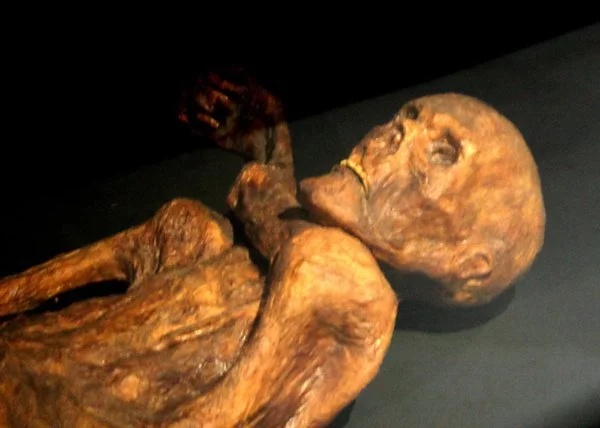While doing research for this month’s issue, I came across an interesting headline, “Cracking the World’s Oldest Cold Case.” The article is by Sarah Pruitt for History.Com. The article is about the Copper Age mummy, Ötzi, the Iceman.
Ötzi lived between 3350 and 3105BC. Two German tourists discovered his remains while hiking at the border between Austria and Italy on September 19, 1991. When they first saw the body, it was so well-preserved they thought it was a recently deceased mountaineer, and they notified the authorities.
The lower half of the torso was frozen in ice, so the body couldn’t be removed by the police. It had to be chipped out using pneumatic drills and pick axes. The first people working to free the body from the ice did not realize the age of the corpse or its importance. They were not archaeologists, and they weren’t trained to handle this sensitive extraction. There was considerable damage done to his remains and his possessions. Bad weather hindered their progress. On September 22, the body was removed and sent to the medical examiner in Innsbruck along with items found nearby that were believed to be his personal effects.
Two days later, an archaeologist, Konrad Spindler of the University of Innsbruck examined the remains and dated them to be at least 4,000 years old based on the articles retrieved from around the body.
After examining the items and tissue samples from the corpse, experts from several scientific institutions concurred that the corpse was someone who lived at least 5,000 years ago. They nicknamed the corpse Ötzi after an area of the Alps known as the Ötztal. Ötzi is Europe’s oldest known natural human mummy. Mummified corpses have typically had their organs removed and their blood replaced with a chemical preservative solution. Ötzi’s body had not been prepared for burial in any way, but his corpse had been frozen soon after his death approximately 5,000 years ago. Because of this, his organs, skin, and the contents of his stomach and intestines were relatively intact.
Two wounds on Ötzi’s body tell the story of how he likely died. A deep gash between his thumb and finger on his right hand is indicative of a defensive would. The skin showed signs of healing indicating he received the wound a few days before his death. The second wound was discovered later. Original X-rays and CT scans showed what medical examiners believed were broken ribs and an unidentified mass under one of his shoulder blades. The medical examiners flagged the area for further tests, but those tests weren’t completed until later.
The image is a piece of a flint arrowhead indicating that Ötzi was likely shot in the back with an arrow, and his death was murder. Also, his ribs weren’t actually broken, they were likely compressed by the weight of the snow and ice covering the body. Ötzi was clutching a dagger in his injured hand though the injury would have made it difficult for him to use the weapon.
Examination of the contents of his stomach and intestines revealed the types of food he had recently eaten which led archaeologists to determine that Ötzi was from Italy not Austria. Custody of his remains was transferred from the University of Innsbruck to a specially designed refrigerated vault in the old bank building in Bolzano. The building is now known as the South Tirol Museum of Archaeology.
Leading archaeologists from several countries have examined Ötzi and his belongings. Researchers estimate he was 5’3” tall and somewhere in his forties. His bones show evidence of osteoarthritis and there were black marks on his legs indicative of tattoos. He wore leather clothing, and his shoes were made of leather stuffed with grass for warmth.
Twenty-five years after Ötzi was discovered, Detective Inspector Alexander Horn of the Munich Police Department received a call from the South Tyrol Museum of Archaeology in Bolzano, Italy. Horn, who is known for his profiling skills, was asked to investigate Ötzi’s murder.
From all the evidence recovered, Horn began the difficult task of reconstructing Ötzi final days. From the defensive wound to his hand, Horn concluded that Ötzi was involved in an altercation probably in his village or nearby. Because the wound was in the process of healing, Ötzi was probably the victor in whatever transpired, and he fled up the mountain for safety leaving his bow and arrow behind. The effects found with Ötzi suggest he was making a new bow and some arrows shortly before he was killed.
Whoever Ötzi fought with (or one of their family members) likely tracked him up the mountain, remained hidden and shot him in the back. The arrowhead broke off while Ötzi was trying to remove the arrow. He must have grabbed his dagger for defense in case the killer came closer. It would have probably been the closest weapon to him. The killer did take Ötzi’s ax, his backpack, or the bow and arrows he was making. Horn theorized that Ötzi’s assailant did not want to be found having any of Ötzi’s possessions which points to murder. Horn enjoyed the challenge of reconstructing Ötzi’s final days, but the one thing he regrets is that there is no way to determine who killed Ötzi or why he was murdered.
Did Ötzi’s killer fear retribution form Ötzi’s family or was there an established code of social behavior that would have punished the killer for shooting Ötzi in the back? We will probably never know. What do you think happened?
Photo Credit:
By 120 - Own work, CC BY-SA 3.0, https://commons.wikimedia.org/w/index.php?curid=15370839
Sources for this article:
https://www.history.com/news/cracking-the-worlds-oldest-cold-case
https://www.smithsonianmag.com/science-nature/testimony-from-the-iceman-75198998/






